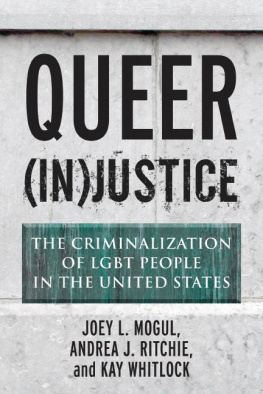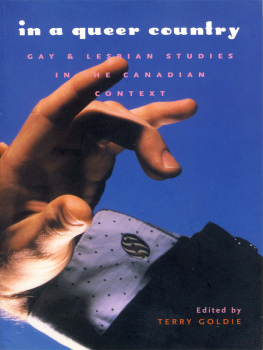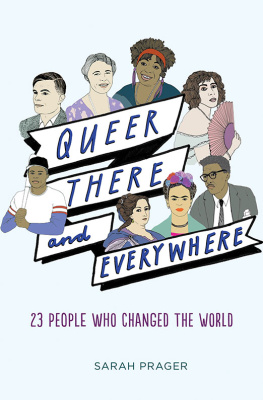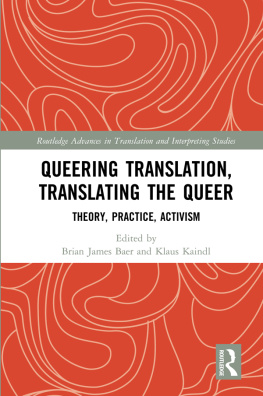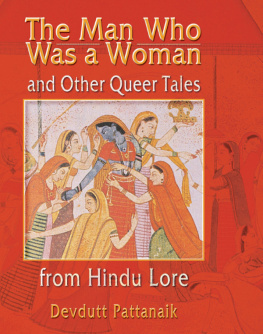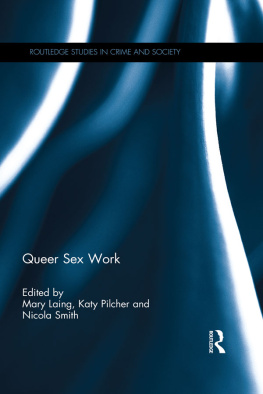Other Books in the Queer Action Series
Come Out and Win: Organizing Yourself, Your Community and Your World by Sue Hyde
Out Law: What LGBT Youth Should Know about Their Legal Rights by Lisa Keen
Other Books in the Queer Ideas Series
Beyond (Straight and Gay) Marriage: Valuing All Families under the Law by Nancy D. Polikoff
From the Closet to the Courtroom: Five LGBT Rights Lawsuits That Have Changed Our Nation by Carlos A. Ball
QUEER (IN)JUSTICE
The Criminalization of LGBT People in the United States
Joey L. Mogul, Andrea J. Ritchie, and Kay Whitlock
Queer Action / Queer Ideas
A Series Edited by Michael Bronski
Beacon Press, Boston
This book is dedicated to all queers who have suffered the violence and violation of the criminal legal system, and to all who have resisted it.
Contents
Colonial Legacies
Queer Criminal Archetypes
Policing Gender, Policing Sex
Treatment of Queers in Criminal Courts
Prisons as Queer Spaces
Criminal Legal Responses to Violence against LGBT People
Where Do We Go from Here?
A Note from the Series Editor
For over sixty years the Queer Movementwhich has transformed itself from the Homophile movement of the 1950s to the Lesbian, Gay, Bisexual, and Transgender movement of todayhas frequently faced overwhelming odds. Throughout those years it found the strength, resources, wit, and ingenuity to grapple with the social, legal, and political discriminations that were part of the everyday lives of LGBT people. But the one area in which these movements have most often failed was in conceptualizingon the most elemental and profound levelhow queer people were both the target of, and often complicit with, the U.S. criminal legal system.
How could this complicity between LGBT people and the criminal legal system have happened? For centuries, under European and American law, acts of queer sexuality were criminalized, frequently with dire consequences to those who were caught. It made perfect sense to many activists that removing the legal sanctions against same-sex sexual activity would constitute real reform. The repeal of sodomy laws was indeed a necessary step in LGBT people securing a wide range of social freedoms, but they were only partially correct. What these activists did not understand was that simply addressing antigay laws ignored both the multiplicity of problems that this legal system generated, as well as the social and cultural complexities of LGBT lives. In Queer (In)Justice: The Criminalization of LGBT People in the United States, Joey Mogul, Andrea Ritchie, and Kay Whitlockall of whom have worked tirelessly for social justice causesuncover the underlying, interlocking causes and effects of how our all-too-basic thinking about sex, poverty, class, race, gender, crime, safety, and punishment in America is contributing to a system that is both out of control and dangerous to all of its citizensespecially those who deviate from socially mandated gender and sexual norms. This book is a wake-up call for the LGBT movement as well as for every person who wants to make America a better and safer place for everyone.
Michael Bronski
Series Editor
Introduction
A Spanish conquistador throws dozens of Indigenous people accused of engaging in sodomy to his hunting dogs. Almost five centuries later, a South Asian migrant worker is convicted of engaging in sodomy with a white man, who goes free. In 2006, seven Black lesbian friends, walking home one night through a well-known gayborhood, are assaulted by a man who threatens to rape one of them straight. They defend themselves, only to be characterized by the media as a lesbian wolf pack and sentenced to up to eleven years in prison. An innocent Latino man spends eleven years behind bars for what police describe as a homosexual murder in 1988. Ten years later a Latina woman ends up on death row after the prosecutor argues she is a hardcore lesbian. At the turn of the twenty-first century, a white gay man is put to death after a prosecutor urges a jury to consider that they are sitting in judgment of an avowed homosexual. A Black gay man who is repeatedly raped in prison is denied protection from prison officials because he is thought to enjoy it. A club frequented primarily by African American LGBT people is raided; 350 people are handcuffed and detained for up to twelve hours, only to be charged with loitering inside a building. In 2008, a Black transgender woman is profiled as engaging in sex work, arrested, called faggot and he/she, and savagely beaten by police officers in a public booking area, in full view of a video camera. Her subsequent murder remains unsolved. These are but a few of the many faces of queer injustice in the United States. Their stories are central to our understandings of crime, safety, and punishment, and to struggles for queer liberation.
Crime has become a national obsession in America. The number of people in state and federal prisons skyrocketed from less than 200,000 in 1970 to 7.5 times that number within four decades. At the end of 2008 there were a total of 2.3 million people behind bars, and over 5 million under the supervision of the criminal legal system. Nearly two-thirds are serving time for nonviolent offenses.
This explosive growth in imprisonmentincreasingly understood as a policy of mass incarcerationhas not resulted in significant reductions in crime rates, nor has it produced safety. As a result, there is increasing recognition across the political spectrum of the need to rethink current approaches.
Mass incarceration is neither a reflection of violence run amok, nor an indication that certain populations are naturally prone to crime. It is deeply rooted in the history and maintenance of racial power relations, and its racially disproportionate impacts are profound. The furor sparked by the 2009 arrest of Harvard professor Henry Louis Gates, Jr., on suspicion of breaking into his own home in a wealthy neighborhood in Cambridge, Massachusetts, prompted acknowledgment of just how extensive racial profiling is. More than 60 percent of prisoners, and two-thirds of people serving life sentences, are people of color. Women are now being incarcerated at almost twice the rate of men; Black and Latina women are approximately three times more likely to be incarcerated than white women. Native women also experience disproportionate rates of incarceration: for example, in Montana in 2008, Native women made up slightly more than 27 percent of women incarcerated in state prison, but only 7 percent of the population. Poverty also plays a critical role in determining access to justice.
Although there is currently no data on incarcerated LGBT people, what information is available suggests that transgender and gender nonconforming people are disproportionately ensnared in the criminal legal system. A 1997 San Francisco Department of Public Health study found that 67 percent of transgender women and 30 percent of transgender men had a history of incarceration. At the same time, LGBT people have increasingly demanded recognition of high levels of homophobic and transphobic violence in the United States. Yet beyond the efforts of mainstream LGBT organizations to frame LGBT people as victims of crime entitled to the full protection of the law, and to strike down sodomy laws, queers have largely been absent from national debates around policing and punishment.
This book turns a queer lens on the criminal legal system in the United States, exposing how the policing of sexual and gender deviance is central to notions of crime, and serves both as a tool of race-based law enforcement and as an independent basis for punishment. By bringing queer experiencesparticularly those of LGBT people of color, immigrants, sex workers, youth, and low-income peopleto the center, we gain a more complete understanding of the ways in which race, national origin, class, gender, ability, and immigration status drive constructions of crime, safety, and justice.

